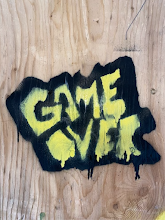 |  |
Sometimes, an artist looses sight of the project they are working on. This has been the case for pretty well two weeks now. It is not a big problem, as I continue to print and continue to experience the work. But two weeks ago I could see the completed work before my mind’s eye, there were clear ideas for sequences and presentation. These are important moments in the production of work as they allow the artist to approach the idea from other angles, by leaving preconceptions aside. This is a normal part of the process.
What is this attraction to industrial architecture? What is this sense that what is human-made
 and, by default, transient is worthy of attention?
and, by default, transient is worthy of attention?In Kant’s “Critique de la Faculté de Juger”, the idea of artistic beauty is derived from and cannot be separated from the philosophical concept of the sublime. In Gilles Deleuze’s analysis the sublime “is explained by the free agreement of reason and the imagination. But this new "spontaneous" agreement occurs under very special conditions: pain, opposition, constraint, and discord. In the case of the sublime, freedom or spontaneity is experienced in boundary-areas, when faced with the formless or the deformed.”1 [The word “entendement” is translated as “agreement” which is perhaps accurate in literal terms but lacks the subtle second meaning of “listening” which is pivotal in Deleuze’s use of language.]
Paraphrasing Gilles Deleuze, in order to understand how the cultural aesthetic can fit within Kant’s three critiques, one has to come to grips with the relationship between natural beauty and artistic beauty and how each relates to reason. He uses the notion of the sublime to bridge this gap, as its relationship to reason is spontaneous and direct because the abject occurs in both modes of expression.
 If the sublime exists as a free agreement (entendement) between reason and the imagination it makes it possible to analyse artistic beauty as the free accord of agreement (entendement) and the imagination. The two concepts are inextricable in this view of beauty. Form and expression are functions of the formless and deformed and create a free and open discourse that can appear to be based in sensibility (taste) but that can be deduced logically and thus find a place in a more global construct of taste. It is possible to arrive at cultural agreement (entendement) on matters of taste and beauty. This, in very broad strokes, forms the basis for Kant’s analysis of beauty and its role in the faculty of judgement.
If the sublime exists as a free agreement (entendement) between reason and the imagination it makes it possible to analyse artistic beauty as the free accord of agreement (entendement) and the imagination. The two concepts are inextricable in this view of beauty. Form and expression are functions of the formless and deformed and create a free and open discourse that can appear to be based in sensibility (taste) but that can be deduced logically and thus find a place in a more global construct of taste. It is possible to arrive at cultural agreement (entendement) on matters of taste and beauty. This, in very broad strokes, forms the basis for Kant’s analysis of beauty and its role in the faculty of judgement.It would follow that the artist could be described as having an acute sense of the relationships between “entendement”, imagination and reason as well as a desire to express these ideas visually and publicly. The search for the abject or the sublime would obviously be part of this process. Examples of this can be found throughout the history of art, from classical to romantic to current periods. An interesting example comes to mind. Edward Weston, who, with his contemporaries, helped create the template for formal photography in North America, is particularly known for exquisitely rendered landscape and still life photographs but there is one image that seems to create context for his work. It is Dead Man, Colorado Desert, 1937. In this image, the sublime (abject) and beauty are articulated with incredible sensibility.
The attraction to industrial architecture and abandoned places is
 in accordance with a long history of aesthetic thought. The immediate link to reason presented by a reality that can be best described as political (the placement and use of fish plants) can be mediated through agreement and imagination to present yet another series of meanings that operate on reason in a wider spectrum of thought.
in accordance with a long history of aesthetic thought. The immediate link to reason presented by a reality that can be best described as political (the placement and use of fish plants) can be mediated through agreement and imagination to present yet another series of meanings that operate on reason in a wider spectrum of thought.These are the last few images from Diamond Cove; starting with the next installment we will begin a visit to Isle Aux Morts.
1. Revue d'esthetique, vol. XVI, no. 2, avril-juin (Paris: PUF, 1963), p. 113-136. This translation borrowed from a 2004 Semiotext(e) translation of L’ile déserte, 2002 Éditions de Minuit.



No comments:
Post a Comment